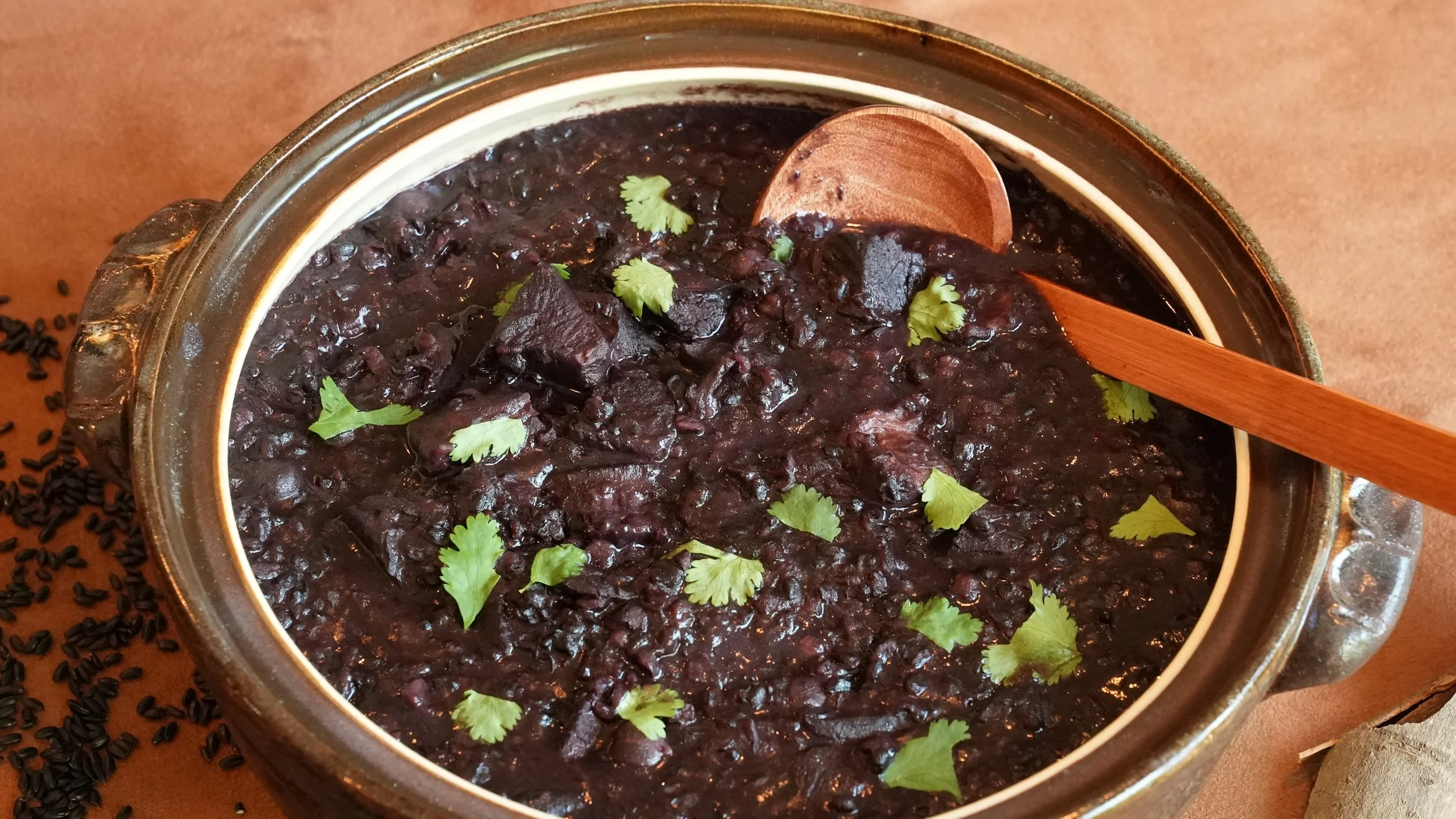Kublai Khan’s Mastic Stew
Mastic stew with black rice, spices, and lamb, garnished with cilantro
City/Region: Mongol Empire | China
Time Period: 1330
The grandson of Genghis Khan, Kublai Khan doubled the size of the largest land empire the world had ever known by conquering China. We actually know quite a bit about the foods that fueled his empire-expanding efforts. Shortly after his death, Yinshàn zhèngyào, or The Proper and Necessary Things for the Emperor’s Food and Drink, was written, and its recipes include ingredients from across Kublai Khan’s vast empire.
The mastic in this stew is a resin from the mastic tree in the Mediterranean, and it has a bitterness along with cedar or pine notes. I really like it in sweet things, but there is no sugar in this dish. The stew is aromatic and smells of cardamom and cinnamon, but they don’t come through in the flavor. The bitterness of the mastic and the lamb dominate the dish, but Kublai Khan was eating this dish to invigorate his chi, so maybe the flavor didn’t matter as much.
I used black rice, or forbidden rice, so named because supposedly it was only eaten by the emperor and his court for much of Chinese history, and it makes the stew a deep purple. You can use long grain white or brown rice, which will make for a lighter colored dish.
“Nourishes, warms the middle and grants chi. Leg of mutton, five tsaoko cardamoms, 2 ch’ien cinnamon, one half sheng chickpeas, mash and remove the skins. Boil the ingredients together to make a soup, strain it. Cut up the meat and set aside. Add 2 ho of cooked chickpeas, 1 sheng of aromatic rice, 1 ch’ien of mastic. Mix well with a little salt. Add chopped meat and cilantro.”
Ingredients:
- 2 1/2 cups (600 g) cooked chickpeas, divided
- 5 black cardamom pods
- 1 tablespoon (7 g) cinnamon, I used pieces of cinnamon bark
- 2 1/2 lbs (1 kg) bone-in leg of lamb
- 2 cups (400 g) rice, I used black rice but you can use long grain white or brown rice
- 2 teaspoons (3.5 g ) ground mastic*
- 1 teaspoon salt
- A few cilantro leaves
*For this recipe, mastic ground with salt is more appropriate than mastic ground with sugar.
Instructions:
- Remove the skins from 2 cups (480 g) of the chickpeas, reserving the remaining 1/2 cup for later. I did this one at a time and actually found it kind of relaxing. When all the skins are removed, mash the 2 cups of chickpeas well, but they will also disintegrate a little more in the stew.
- Crush the cardamom pods and cinnamon (if you’re using pieces of cinnamon bark). It’s okay if there are some larger pieces left because we’re going to strain it later.
- In a large pot combine the leg of lamb, skinned and mashed chickpeas, cardamom, and cinnamon. Pour in 3 quarts (3 L) of water and set the pot over high heat and bring it to a boil. Once it boils, reduce it to a simmer, put the lid on, and let it simmer for 2 hours or until the meat is very tender. Check it every once in a while and skim off any scum and foam that has risen to the top.
- When the meat is tender, remove the pot from the heat and remove the meat from the pot. Pour the broth through a strainer, pressing as much liquid out of the mashed chickpeas as possible. Return the broth to the pot.
- Rinse the rice in cool water a few times, then add it to the pot. Stir in the reserved whole unskinned chickpeas, mastic and the salt. Set the pot over medium heat and bring it to a boil. Reduce the heat to low, cover the pot with the lid, and cook for 30 minutes. After 30 minutes, take it off the heat and let it sit, covered, for 10 minutes so the rice can soak up more of the broth.
- While the pot sits, take the leg of lamb and remove the meat from the bone and chop the meat into small pieces.
- After the pot has sat covered off the heat for the 10 minutes, stir in the meat. Taste and add more salt if desired. Dish it up, scatter the cilantro leaves over it, then serve it forth.
Notes
- Mastic is a gum or resin from the mastic tree on the Greek island of Chios. It starts off bitter, then gets a sweet pine flavor that’s kind of like walking through a forest. Really wonderful in moderation, not quite to my taste in this stew.
- Link to mastic: https://amzn.to/4kTNAWU
Some links on this site are affiliate links. If you buy something through them, it does not cost you anything more, but we will get a small commission which helps keep the site up and running. Thanks!


